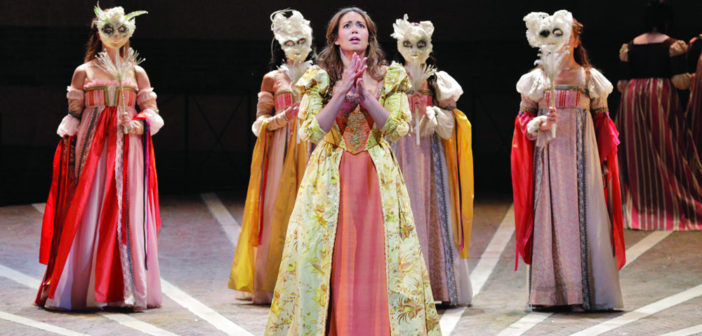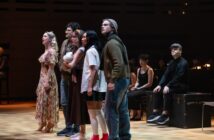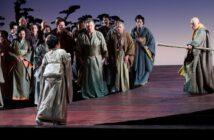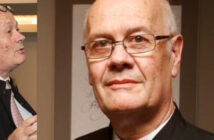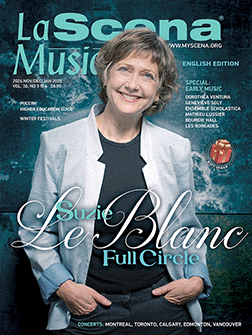
This page is also available in / Cette page est également disponible en:
![]() Francais (French)
Francais (French)
Opera singers who boast contracts with big-name recording labels are rare these days, but American soprano Nadine Sierra can count herself among that select few. Her newly-released album on Deutsche Grammophon is entitled Made for Opera. Eschewing the more usual calling-card list of standard lyric soprano arias, Sierra takes a more curated approach, focusing on three iconic heroines, all of whom she has sung multiple times on stage. Verdi’s Violetta in La traviata, Donizetti’s Lucia di Lammermoor and Gounod’s Juliette from Roméo et Juliette are presented in most of their major arias and scenes. The Italian selections are injected with a dose of authenticity by her partners on the album, the Orchestra Sinfonica Nazionale della RAI (Radiotelevisione italiana) conducted by Italian 19th-century specialist, Riccardo Frizza.
Sierra’s inspiration for her program, at least in part, is a desire to pay tribute to the strong women who have shaped her life, honouring them with the powerful female characters she interprets on this album. “I got into opera because of the strong women in my life, and the one woman in my life, my grandmother on my mother’s side, who was never allowed to pursue any kind of working career, had wanted to be an opera singer herself,” says Sierra. So, when the soprano showed early signs of loving music—and singing in particular—her mother recognized Sierra was following in her grandmother’s footsteps, and that she should be encouraged.
The singer grew up in Fort Lauderdale, supported by a family that made sacrifices for their children’s betterment. “My dad had to work in this private school [she attended for a year]in order to pay for the tuition for me and for my eldest sister. We couldn’t just go like the other kids who didn’t even think about where the money was coming from. They would see our dad on campus and they would make fun of us,” recalls Sierra.
Sierra latched onto opera from a very young age. She began vocal lessons at age six, and when she was 10, her mother borrowed a video from the local library of Franco Zeffirelli’s iconic Metropolitan Opera production of La Bohème starring Canadian soprano Teresa Stratas. Sierra was mesmerized.
This set her on a career path that began at Palm Beach Opera where she made her professional debut at age 16 as the Sandman in Humperdinck’s Hansel and Gretel. She went on to obtain a bachelor’s degree from New York City’s prestigious Mannes School of Music, and then attended Marilyn Horne’s Music Academy of the West where she became the youngest person ever to win the Marilyn Horne Foundation Vocal Competition. The legendary American mezzo continued to be a key mentor, encouraging Sierra to enter the Metropolitan Opera National Council Auditions at age 20. There, Sierra triumphed as the youngest competitor ever to win what is considered one of the world’s most important vocal competitions. Her subsequent, long association with San Francisco Opera began in 2011 when she joined the company’s young artist training division, the renowned Adler Program.
Sierra’s artistry has been recognized with a long list of important awards, the most prestigious being Germany’s Neuen Stimmen competition (2013), the Richard Tucker Music Award (2017) and the Beverly Sills Artist Award for young singers at the Metropolitan Opera (2018).
Sierra’s early ascendance to singing big roles at the world’s most famous opera houses might raise red flags of concern about “too much, too soon,” but the soprano is extremely focused on maintaining vocal health. In a 2019 Opera Wire piece, she cites the importance of checking in regularly with a vocal coach or teacher whom she trusts: “Even if you have to make time in your schedule to go see them for a week or two to brush up on your technique or any musical issues you’re having, don’t be afraid to do so. Oftentimes, young singers feel they need to fill up their schedule in order to become ‘prestigious’ in this business, but really, quality of voice and artistry will always win over quantity!” For Sierra, this crucial pedagogical role has been fulfilled by her longtime coach Kamal Khan. She says he has been part of her “life for 21 years, since I was 13 years old, and we have worked basically every role that I’ve ever learned in my life together, in depth.”
Even though 34 is still young by opera-singer standards, Sierra has been performing on major stages for almost 10 years. One of her most prominent roles is Lucia, well-represented on the new album with both of the character’s lengthy scenes, including the iconic “mad scene.” Sierra first sang Lucia in Zurich in 2015, then later that year in San Francisco when she jumped in with little notice for German star soprano Diana Damrau in Canadian director Michael Cavanagh’s production. In 2017, at Venice’s fabled Teatro La Fenice, her Lucia was led by Italian conductor Riccardo Frizza with whom she has had a long collaboration. He not only conducts on the new album, but will also lead her upcoming Metropolitan Opera Lucia this April in Australian director Simon Stone’s new production. Sierra says Frizza “has known how my voice has developed over the years, so I trust Riccardo very much… It made the recording process easier. And being Italian, this also plays a huge part. And he’s also a bel canto expert.”
Sierra is of one-quarter Italian extraction and revels in that heritage. Making this bel canto-focused recording in Italy, with an Italian conductor and orchestra made “a big difference in these kinds of, let’s say, pressurized moments,” where it helped to be surrounded by colleagues who are steeped in the ottocento repertoire. That connection to the Italian tradition extends to some of her musical choices on the album as well. The unusual, beautifully expressive cadenza she sings at the end of Violetta’s “Ah fors’è lui” was suggested by Khan, her vocal coach. “He worked very closely with [legendary Italian soprano]Renata Scotto at some point in his life. And this [cadenza]is actually coming from Renata herself.”
Precocious talent like Sierra’s was inevitably accompanied by proposals for roles before she felt quite ready to take them on. She cites an early offer of Mimì in La Bohème at age 23, and in 2017 she stepped away from singing Massenet’s Manon in San Francisco though she adds “now that I’m almost 34, things have changed quite significantly since then. Manon would be absolutely something that I can take on now.” There is a reminiscence of Mirella Freni’s Italianate sound in Sierra’s rich, dark tonal quality, so it’s not surprising that impresarios have tried to foist heavier lyric roles on her prematurely. The soprano is adamant that she needs “to be the responsible one. And tell people, even if it annoys them—because sometimes it does annoy them; they really feel like they’re right. Because of this sound [I have]. But I ultimately am the one that carries the responsibility, should I—you know—fail.”
One role Sierra obviously feels very comfortable with is Lucia. We spoke while she was in Munich, singing Donizetti’s doomed Scottish heroine at the Bavarian State Opera in a revival of Polish actor and director Barbara Wysocka’s 2015 production set in 1960s Kennedy-era USA. With hardly a pause she’ll be back in the USA at the end of March to begin rehearsals for a new production of Lucia at Metropolitan Opera, another concept updated, according to the company’s press materials, to the “present-day American Rust Belt, an area once prosperous but now fallen into decline and neglect.”
 How do reimaginings like Wysocka’s in Munich, and Simon Stone’s at the Met help Sierra interpret the role? “I’m a modern woman,” she says, “and I express certain emotions very differently than would say, a woman like Lucia as she’s [originally]written. And so, sometimes I feel like I can convey the character in a more honest way—in a more present-day context.” Sierra adds that a contemporary setting “highlights a little bit more of how messed up [Lucia’s] family life is—how significant that is, to what she ends up doing. [She’s] not just some crazy young girl snapping in a moment because she’s not happy with the outcome of her life. She’s kind of been made for this moment.”
How do reimaginings like Wysocka’s in Munich, and Simon Stone’s at the Met help Sierra interpret the role? “I’m a modern woman,” she says, “and I express certain emotions very differently than would say, a woman like Lucia as she’s [originally]written. And so, sometimes I feel like I can convey the character in a more honest way—in a more present-day context.” Sierra adds that a contemporary setting “highlights a little bit more of how messed up [Lucia’s] family life is—how significant that is, to what she ends up doing. [She’s] not just some crazy young girl snapping in a moment because she’s not happy with the outcome of her life. She’s kind of been made for this moment.”
Sierra can draw on real-life experience when it comes to the type of “once great” community in which the new Met Lucia will be set. “I grew up in Fort Lauderdale, and in a family that definitely struggled with money. To a point where my sisters and I lived in a good part of Fort Lauderdale, but not the best. And it meant I went to a magnet school in middle school, that was in, I think, Plantation, Florida. And I would say [for]the majority of the kids, there was a lot of oppression going on, within these families. It left a very big impression on me. I was bullied a lot when I was young, too, and felt a lot of pressure for wanting to better my life,” says Sierra. “Thank God that part of my life was short-lived,” she adds, and in terms of the community and family dynamic faced by Lucia: “I get it.”
As for the soprano’s future plans, Sierra reiterates her determination to be her own best advocate for the roles she hopes to sing: “I just want to make sure that I’m making all the right decisions based on the trajectory that I want in my development vocally. I really advocate for myself—and absolutely, to keep saying no. I’m going to be honest with you. I really don’t know what I am. I feel like I’m in limbo of being this lyric coloratura. I’ve never seen myself as a coloratura, never! I feel like I’m a fake coloratura, really. Because I am waiting for the moment when my voice will be 100 per cent ready for the more lyric repertoire—that I can feel deep down is going to really be my niche.” In terms of the bel canto, coloratura roles for which she is currently in such demand, she half-jokes she performs that repertoire “because I can sing it. And I do love it, but I do feel that there are people around who can sing it better than I can and in ways are far more convincing because it really is their fach. So, I guess, I feel like I’ve been in the waiting room. You know, like reading really pretty magazines, [while]waiting for my appointment. Right?”
Nadine Sierra sings the title role in Metropolitan Opera’s new Lucia di Lammermoor on April 23, 26, 29 and May 2, 6, 10, 14, 17 and 21 followed by a return to Milan’s Teatro alla Scala as Gilda in Rigoletto on June 20. 23, 27, 30 and July 2, 5, 8 and 11.
www.gmartandmusic.com/vocalists/sierra
www.metopera.org
www.teatroallascala.or
This page is also available in / Cette page est également disponible en:
![]() Francais (French)
Francais (French)

